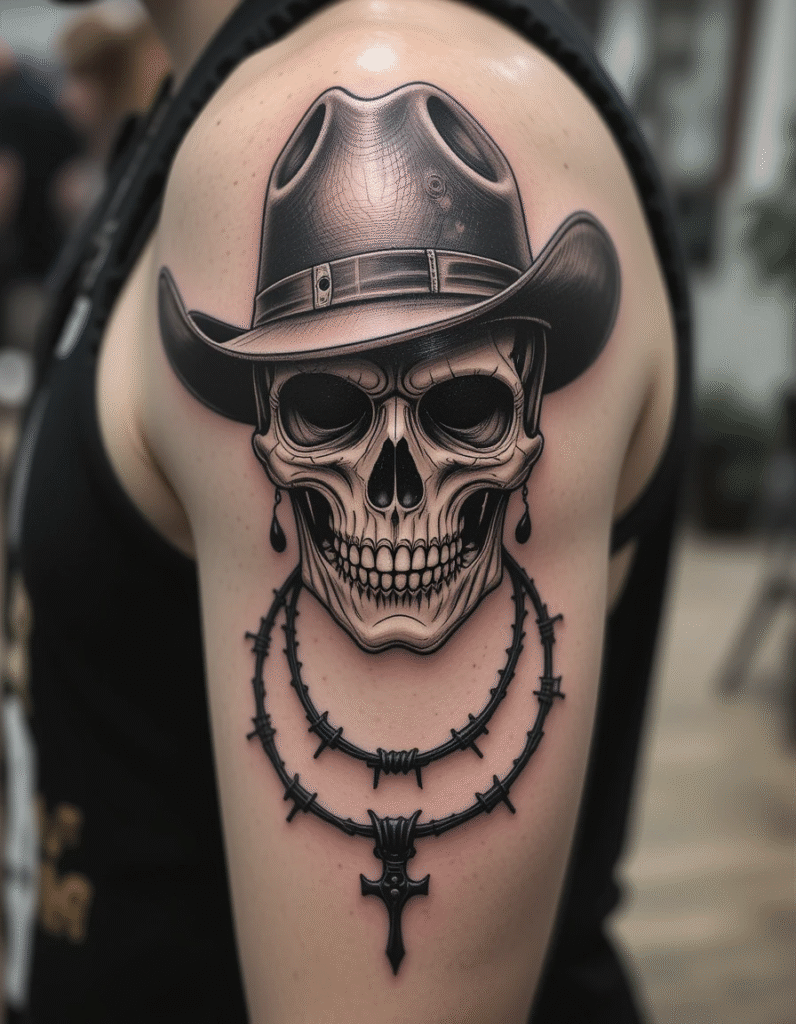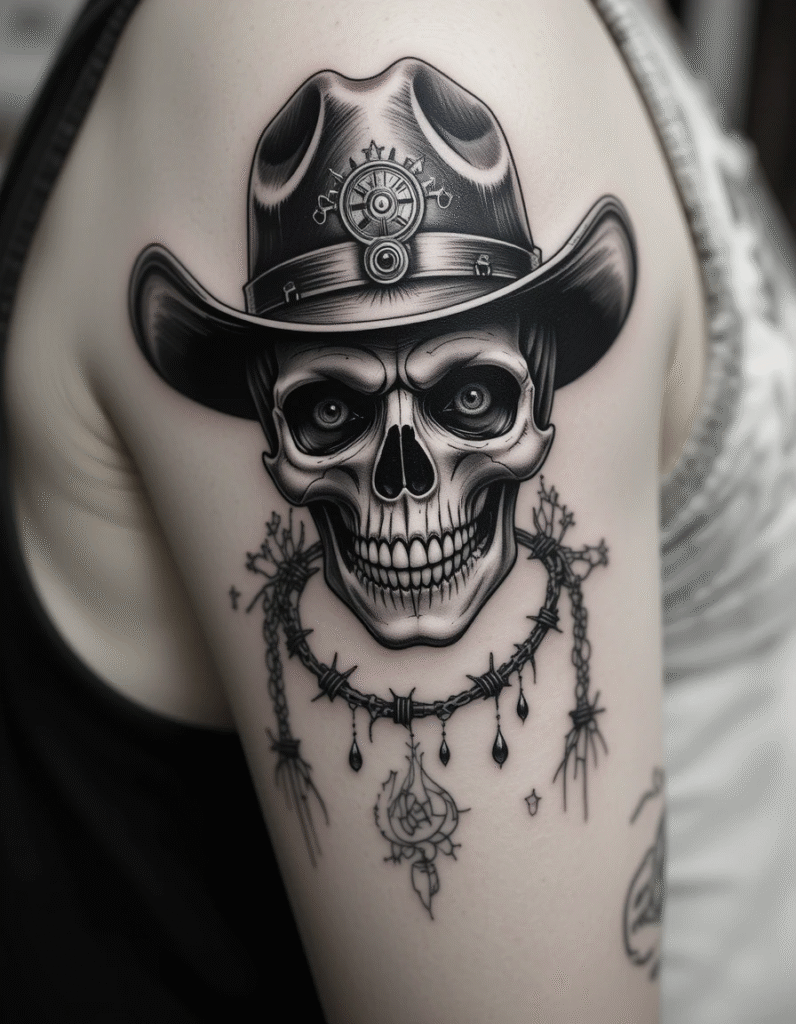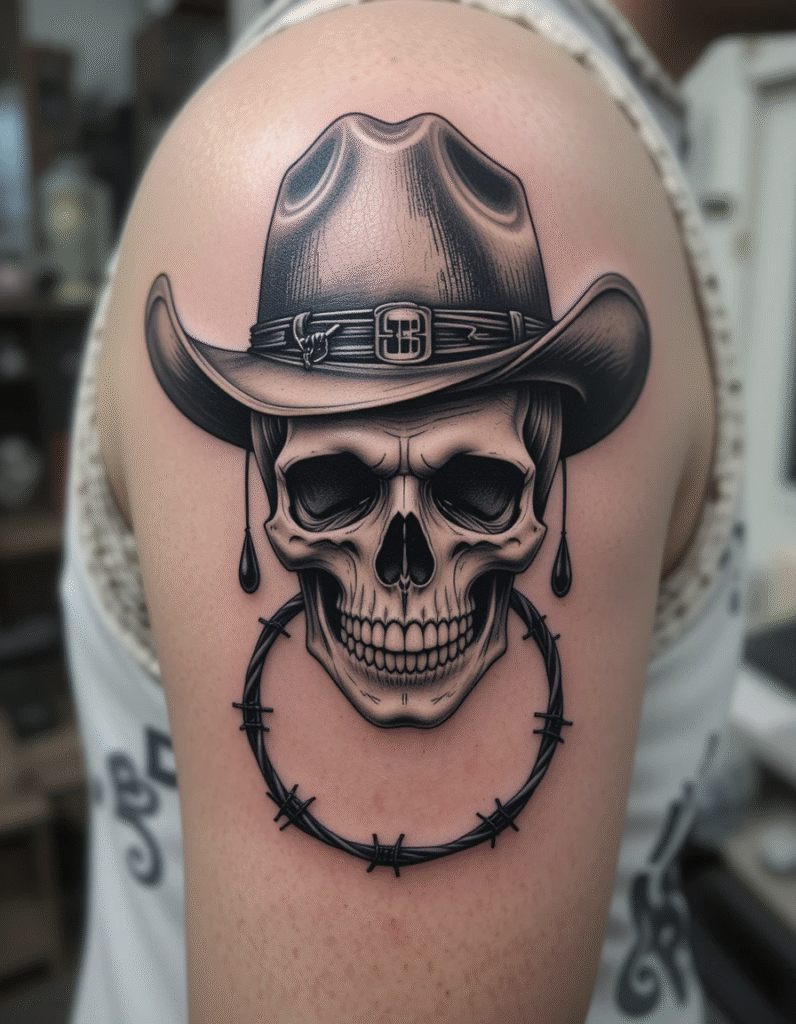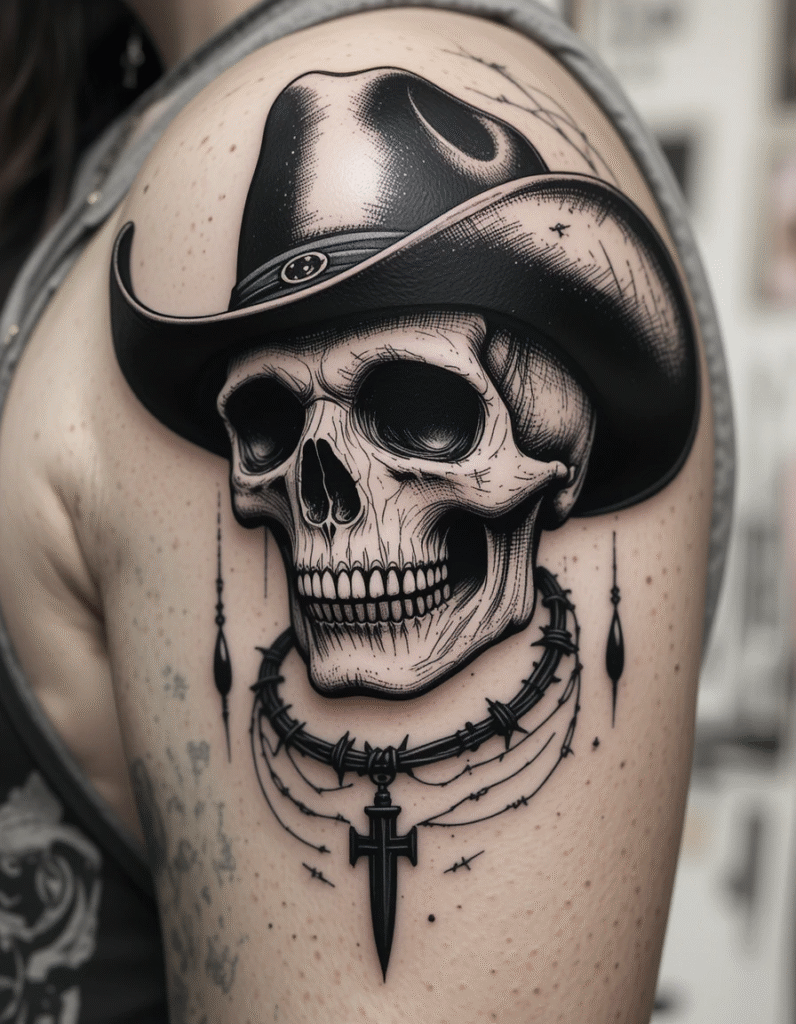In the rich tapestry of tattoo symbolism, few images capture the essence of rugged individualism and mortality’s acceptance quite like the cowboy skull. These powerful designs merge the romanticism of the American frontier with the universal contemplation of life’s finite nature, creating body art that speaks to both personal strength and philosophical depth. The masterful tattoos showcased here demonstrate how contemporary artists transform traditional Western imagery into sophisticated statements of identity, resilience, and spiritual awareness.
The Sacred Symbolism of the Cowboy Skull
The cowboy skull represents a unique fusion of American frontier mythology with timeless symbols of mortality and transformation. This powerful imagery draws from multiple cultural traditions while creating something distinctly contemporary and deeply personal.
The Cowboy as Archetype
The cowboy figure has evolved from historical reality into powerful symbolic territory:
- Independence: The ultimate symbol of self-reliance and personal freedom
- Courage: Facing danger and uncertainty with unwavering resolve
- Honor: Living by a personal code that transcends social conventions
- Adventure: Embracing the unknown and seeking new horizons
- Authenticity: Remaining true to one’s nature despite external pressures
- Resilience: Surviving and thriving in harsh, unforgiving environments
When combined with skull imagery, these qualities take on deeper philosophical dimensions, suggesting not just toughness, but wisdom gained through confrontation with life’s ultimate realities.
Skull Symbolism Across Cultures
The skull serves as one of humanity’s most potent symbols, carrying meanings that transcend cultural boundaries:
- Mortality awareness: Acknowledgment of life’s precious, temporary nature
- Transformation: Death as passage rather than ending
- Fearlessness: Courage in facing life’s most fundamental uncertainty
- Wisdom: Knowledge gained through contemplation of existence’s deeper truths
- Protection: Paradoxically, death imagery often serves as spiritual armor
- Rebellion: Rejection of society’s tendency to deny or fear mortality
The combination creates a uniquely American approach to these universal themes, filtered through the lens of frontier experience and Western cultural values.

The Art of Western Gothic Aesthetic
These cowboy skull tattoos represent a sophisticated evolution of Western gothic style, blending traditional American imagery with darker philosophical undertones.
Hat as Crown and Identity Marker
The cowboy hat serves multiple symbolic functions in these designs:
- Authority: The hat as a crown representing personal sovereignty
- Identity: Immediate recognition of Western cultural alignment
- Protection: Shelter from both physical and metaphorical storms
- Tradition: Connection to historical Western heritage and values
- Status: Different hat styles conveying various aspects of cowboy identity
- Continuity: The hat remains while the wearer has passed, suggesting lasting legacy
The detailed rendering of hat bands, creases, and weathering tells stories of experience and character, making each design uniquely personal while maintaining universal Western appeal.
Barbed Wire: Beauty in Brutality
The barbed wire elements in these tattoos add layers of complex symbolism:
- Boundaries: Personal limits and the protection of sacred space
- Hardship: Beauty emerging from life’s most challenging experiences
- Confinement: The paradox of freedom within necessary limitations
- Protection: Defensive measures that both shelter and isolate
- Industry: The taming of the frontier and civilization’s advance
- Sacrifice: The price paid for security and territorial integrity
The circular arrangement of barbed wire creates a mandala-like effect, transforming an instrument of separation into a symbol of wholeness and protection.
Technical Mastery in Skull Portraiture
Creating realistic skull imagery requires exceptional technical skill and deep understanding of human anatomy combined with artistic vision.
Anatomical Precision and Artistic Interpretation
These tattoos demonstrate masterful balance between scientific accuracy and artistic expression:
- Bone structure: Precise rendering of cranial anatomy and proportions
- Weathering effects: Artistic interpretation of how time affects organic materials
- Dimensional depth: Creating three-dimensional appearance on flat skin surfaces
- Shadow and highlight: Advanced understanding of light interaction with complex forms
- Texture variation: Different surface treatments for various materials and ages
- Proportional harmony: Ensuring all elements work together despite varying scales
This level of anatomical accuracy combined with artistic interpretation creates designs that are both educational and emotionally resonant.
Line Work Excellence and Shading Sophistication
The technical execution visible in these pieces showcases several advanced tattoo techniques:
- Consistent line weight: Maintaining uniform thickness throughout complex curved surfaces
- Gradient mastery: Smooth transitions between light and dark creating realistic dimensionality
- Fine detail retention: Preserving intricate elements like hat stitching and wire texture
- Negative space utilization: Using untattooed skin as integral part of the composition
- Contrast management: Balancing dramatic darks with subtle highlights for maximum impact
- Surface adaptation: Adjusting flat designs to work with arm’s natural contours
This level of technical execution requires years of specialized training and represents the highest standards of contemporary tattoo artistry.

Placement and Composition Strategies
The arm placement of these cowboy skull tattoos demonstrates sophisticated understanding of how body art interacts with human anatomy and movement.
Upper Arm as Gallery Space
The upper arm provides ideal conditions for complex tattoo work:
- Muscle definition: How tattoos interact with bicep and deltoid contours
- Viewing angles: Designs that work from multiple perspectives
- Size accommodation: Sufficient space for detailed, complex imagery
- Healing advantages: Less movement and friction during recovery period
- Professional flexibility: Easy concealment when required by dress codes
- Age considerations: How designs will adapt as muscle tone changes over time
This placement choice reflects practical wisdom combined with aesthetic sophistication.
Composition Flow and Visual Movement
These designs demonstrate advanced understanding of compositional principles:
- Central focus: The skull as primary visual anchor point
- Supporting elements: How hat and barbed wire enhance rather than compete
- Directional flow: Leading the eye through the design in intentional patterns
- Balance points: Distribution of visual weight for optimal harmony
- Breathing room: Strategic use of negative space to prevent visual overcrowding
- Scale relationships: Ensuring all elements work together proportionally
This sophisticated approach to composition elevates these tattoos from simple imagery to complex visual storytelling.
Cultural Context and American Identity
Cowboy skull tattoos tap into deep currents of American cultural identity and mythology.
Frontier Mythology and Modern Identity
The enduring appeal of cowboy imagery reflects core American values:
- Self-determination: The belief in individual agency and personal responsibility
- Meritocracy: Success through skill, courage, and hard work rather than birth or connections
- Anti-authoritarianism: Healthy skepticism of excessive governmental or social control
- Pragmatism: Problem-solving through practical action rather than theoretical abstraction
- Mobility: The freedom to reinvent oneself and seek new opportunities
- Direct communication: Honest, straightforward interaction without excessive social pretense
These values resonate across generational and cultural lines, making cowboy imagery timelessly relevant to American identity formation.
Regional Variations and Personal Interpretation
Different regions and individuals bring unique perspectives to cowboy skull symbolism:
- Southern interpretations: Emphasis on honor, tradition, and family legacy
- Western perspectives: Focus on freedom, space, and connection to landscape
- Urban adaptations: How city dwellers relate to frontier mythology and values
- Generational differences: How millennials and Gen Z interpret traditional Western imagery
- Gender variations: How women embrace and reinterpret traditionally masculine symbolism
- Cultural fusion: Integration with other ethnic and cultural traditions
This flexibility allows cowboy skull tattoos to serve diverse personal and cultural needs while maintaining core symbolic integrity.
The Psychology of Mortality Art
Choosing to wear death imagery carries profound psychological implications that extend far beyond aesthetic considerations.
Confronting Mortality Through Art
Skull tattoos serve important psychological functions:
- Anxiety management: Transforming death fear into artistic appreciation
- Life prioritization: Daily reminders of existence’s precious, limited nature
- Courage cultivation: Building comfort with life’s most fundamental uncertainty
- Perspective maintenance: Keeping daily problems in proper proportion
- Authenticity encouragement: Living more honestly when aware of life’s brevity
- Legacy consciousness: Considering what lasting impact one’s life will have
This psychological work transforms skull tattoos from morbid fascination into tools for deeper, more meaningful living.
Social Signaling and Tribal Identity
Wearing cowboy skull imagery communicates specific messages about personal values:
- Nonconformity: Willingness to embrace imagery others might find disturbing
- Philosophical depth: Comfort with life’s deeper questions and mysteries
- Cultural alignment: Identification with Western values and traditions
- Strength projection: Suggesting personal toughness and resilience
- Artistic appreciation: Recognition of skill and beauty in dark imagery
- Conversation starting: Inviting discussions about meaning, mortality, and values
These social functions make cowboy skull tattoos powerful tools for identity expression and community building.

The Spiritual Dimensions of Western Death Imagery
Beyond cultural and psychological factors, cowboy skull tattoos often carry deep spiritual significance.
Indigenous Influences on Western Spirituality
The American West’s spiritual landscape incorporates Native American perspectives on death and transition:
- Cyclical understanding: Death as part of natural cycles rather than termination
- Ancestral connection: The deceased maintaining relationship with the living
- Animal guides: Skulls as symbols of spiritual guidance and protection
- Sacred geography: Connection between personal mortality and landscape spirituality
- Vision quest traditions: Death imagery as part of spiritual seeking and transformation
- Shamanic symbolism: Skulls as tools for accessing non-ordinary reality
These indigenous influences add layers of spiritual depth to what might otherwise be purely secular imagery.
Christian and Western Religious Interpretations
Traditional Western religious perspectives also inform cowboy skull symbolism:
- Memento mori: The Christian tradition of mortality contemplation for spiritual growth
- Resurrection hope: Death as passage to eternal life rather than ending
- Martyrdom: Willingness to die for principles and beliefs
- Pilgrimage: Life as journey toward spiritual destination
- Apocalyptic imagery: Skulls as symbols of final judgment and transformation
- Saint traditions: Holy figures who embraced poverty, suffering, and mortality
This religious dimension allows cowboy skull tattoos to serve contemplative and devotional functions.
Fashion Integration and Lifestyle Considerations
Cowboy skull tattoos create unique opportunities and challenges for fashion expression and lifestyle integration.
Wardrobe Coordination and Style Enhancement
These tattoos interact with clothing choices in specific ways:
- Western wear enhancement: How tattoos complement boots, hats, and traditional Western fashion
- Urban style integration: Incorporating Western gothic elements into contemporary city fashion
- Professional presentation: Managing tattoo visibility in various workplace environments
- Seasonal considerations: How different clothing requirements affect tattoo display
- Color coordination: Choosing clothing colors that enhance rather than clash with tattoo elements
- Accessory relationships: How jewelry, watches, and other accessories interact with tattoo designs
Thoughtful fashion integration helps ensure tattoos enhance rather than complicate personal style goals.
Activity and Lifestyle Adaptation
Cowboy skull tattoos often reflect and influence lifestyle choices:
- Outdoor activities: Connection to camping, hunting, fishing, and other frontier-related pursuits
- Music preferences: Alignment with country, rock, and Americana musical traditions
- Vehicle choices: Preferences for trucks, motorcycles, and other utilitarian transportation
- Recreation patterns: Attraction to rodeos, Western festivals, and outdoor events
- Social circles: Connection with others who share Western values and aesthetics
- Travel destinations: Interest in Western historical sites and frontier landscapes
These lifestyle connections create coherent identity expression that extends far beyond the tattoo itself.
Choosing the Right Artist for Western Gothic Work
The complexity and cultural significance of cowboy skull tattoos require specialized artistic expertise and cultural understanding.
Technical Skill Requirements for Realistic Skull Work
Artists specializing in this imagery must demonstrate:
- Anatomical knowledge: Deep understanding of human skull structure and proportions
- Shading mastery: Advanced techniques for creating realistic three-dimensional effects
- Fine line precision: Ability to render intricate details like hat stitching and wire texture
- Composition skills: Understanding how to balance multiple complex elements
- Cultural awareness: Respectful treatment of Western imagery and its cultural significance
- Portfolio evidence: Previous work demonstrating competence in similar projects
Researching an artist’s background in both technical skill and cultural understanding is essential for achieving authentic results.
Artistic Vision and Cultural Sensitivity
Beyond technical competence, the right artist will demonstrate:
- Western heritage understanding: Genuine appreciation for frontier history and values
- Gothic aesthetic sensibility: Comfort with dark imagery and its philosophical implications
- Collaborative approach: Willingness to work with clients to achieve personally meaningful results
- Historical accuracy: Knowledge of period-appropriate details in clothing and equipment
- Symbolic awareness: Understanding of how different elements contribute to overall meaning
- Professional ethics: Honest communication about realistic expectations and outcomes
The relationship between artist and client becomes particularly important for culturally and personally significant work.
Regional Variations and Cultural Authenticity
Cowboy skull tattoos manifest differently across various American regions, reflecting local history and cultural emphases.
Texas and Southwest Interpretations
The American Southwest brings specific cultural elements to cowboy skull imagery:
- Mexican influence: Integration of Día de los Muertos aesthetics and symbolism
- Desert imagery: Incorporation of cacti, desert landscapes, and arid environment symbols
- Oil industry connections: References to petroleum, ranching, and energy production
- Border culture: Fusion of Anglo and Hispanic traditions and values
- Historical depth: Connection to deeper historical traditions predating Anglo settlement
- Architectural elements: Adobe, missions, and other regional building styles
These regional influences create authentically localized versions of universal Western themes.
Northern Plains and Mountain West Perspectives
Different Western regions contribute unique elements:
- Native American integration: More prominent incorporation of indigenous symbols and traditions
- Mining heritage: References to gold, silver, and mineral extraction history
- Mountain imagery: Integration of peaks, forests, and alpine environments
- Ranching traditions: Emphasis on cattle, horses, and agricultural heritage
- Frontier hardship: Focus on survival, isolation, and environmental challenges
- Conservation values: Modern Western emphasis on environmental protection and sustainability
Understanding these regional variations helps create tattoos that reflect authentic connection to specific Western traditions.
The Evolution of Western Tattoo Traditions
Cowboy skull tattoos represent the latest evolution in a long tradition of Western-themed body art.
Historical Development of Western Tattoo Imagery
The progression of Western tattoo motifs reflects changing cultural attitudes:
- Early 20th century: Simple cowboy and horse imagery for ranch workers and rodeo performers
- Mid-century: Pin-up cowgirls and romanticized frontier scenes
- Outlaw era: Emphasis on rebellion, motorcycles, and anti-establishment themes
- Neo-traditional movement: Sophisticated artistic treatment of classic Western imagery
- Contemporary fusion: Integration with other cultural traditions and modern aesthetics
- Future directions: Emerging trends in Western gothic and frontier spirituality
This historical progression shows how Western tattoo imagery continues to evolve while maintaining core cultural connections.
Modern Innovations in Western Tattoo Artistry
Contemporary artists are pushing the boundaries of traditional Western imagery:
- Photorealistic techniques: Extremely detailed rendering approaching photograph quality
- Color innovations: Advanced pigments creating more vibrant and lasting Western scenes
- Cultural fusion: Respectful integration with other ethnic and cultural traditions
- Minimalist approaches: Stripped-down versions focusing on essential symbolic elements
- Abstract interpretations: Non-literal treatments that capture Western spirit rather than literal imagery
- Technology integration: Digital design tools helping artists visualize complex Western compositions
These innovations ensure that Western tattoo traditions remain vital and relevant for new generations.
Economic Considerations and Investment Value
Quality cowboy skull tattoos represent significant financial commitments that require careful consideration and planning.
Pricing Factors for Complex Western Work
Several elements influence the cost of superior cowboy skull tattoos:
- Artist expertise: Premium pricing for specialists in realistic skull and Western imagery
- Design complexity: Multiple elements and fine details requiring extensive session time
- Size considerations: Larger pieces commanding higher prices due to increased time investment
- Custom design work: Original artwork development adding to overall project costs
- Geographic location: Regional variations in tattoo pricing and artist availability
- Studio reputation: Established shops with proven track records charging premium rates
Understanding these cost factors helps in budgeting appropriately for quality work that will provide lasting satisfaction.
Long-term Value and Maintenance Considerations
The true investment in cowboy skull tattoos extends beyond initial application:
- Touch-up requirements: Periodic maintenance to keep details sharp and colors vibrant
- Aftercare costs: Quality products and professional care during healing periods
- Lifestyle adjustments: Potential changes in activities or clothing to protect tattoo investment
- Professional maintenance: Regular consultations with tattoo artists about care and preservation
- Enhancement opportunities: Future additions or modifications to expand design themes
- Insurance considerations: Understanding coverage for tattoo-related medical or professional issues
Viewing these tattoos as long-term investments helps ensure decisions that provide lasting value and satisfaction.
The Social Impact of Western Gothic Body Art
Cowboy skull tattoos influence not only personal identity but also broader cultural conversations about mortality, tradition, and American values.
Challenging Social Taboos Around Death Imagery
These tattoos contribute to important cultural work:
- Normalizing mortality discussion: Making death-related conversations more socially acceptable
- Reducing death anxiety: Helping society develop healthier relationships with mortality
- Artistic appreciation: Encouraging recognition of beauty in traditionally disturbing imagery
- Cultural bridge-building: Creating connections between different approaches to death and spirituality
- Educational opportunities: Prompting discussions about Western history, values, and traditions
- Stereotype challenging: Demonstrating sophistication and depth in traditionally dismissed subcultures
This social impact extends far beyond individual aesthetic choices to influence broader cultural attitudes.
Building Community Through Shared Imagery
Cowboy skull tattoos create connections among diverse individuals:
- Tribal bonding: Shared imagery creating instant recognition and connection
- Cross-generational communication: Bridging age gaps through common symbol appreciation
- Regional identity: Strengthening connections to specific geographic and cultural areas
- Interest group formation: Bringing together people with shared values but different backgrounds
- Cultural preservation: Helping maintain Western traditions in increasingly urban society
- Artistic community: Supporting tattoo artists specializing in Western and gothic imagery
These community-building functions make cowboy skull tattoos powerful tools for social connection and cultural continuity.
Conclusion: Riding the Range Between Life and Death
Cowboy skull tattoos represent one of contemporary body art’s most philosophically sophisticated and culturally rich traditions. These powerful images unite America’s frontier mythology with humanity’s eternal contemplation of mortality, creating deeply personal art that speaks to universal experiences while honoring specific cultural heritage.
The masterful examples showcased here demonstrate how skilled artists can transform traditional Western imagery into contemporary statements of remarkable depth and beauty. They invite us to consider our own relationships with courage, independence, mortality, and meaning while connecting us to the enduring appeal of frontier values and Western aesthetics.
For those drawn to the profound symbolism of cowboy skull imagery, these tattoos offer opportunities to wear one’s philosophical and cultural commitments on one’s skin. They represent not just artistic achievement, but statements of identity that honor both individual courage in facing life’s fundamental realities and collective heritage rooted in America’s frontier experience.
In the expanding universe of tattoo artistry, cowboy skull tattoos stand as testament to the power of combining traditional imagery with contemporary technique and philosophical depth. They remind us that the best body art does more than decorate—it proclaims who we are, what we value, and how we choose to ride the trail between the certainties of life and the mysteries that lie beyond.
These tattoos carry forward the spirit of the American frontier into contemporary life, suggesting that the courage, independence, and authenticity that defined the cowboy era remain relevant and necessary for navigating the challenges of modern existence. They represent art that doesn’t just adorn the body, but fortifies the spirit for whatever adventures and adversities the trail ahead might hold.


